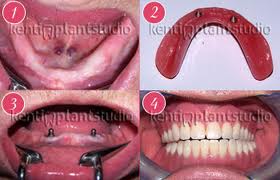Having chipped, worn, stained or missing one or more teeth can have a significant effect on a person's personality, confidence and thus general happiness. Luckily, advancement in cosmetic dentistry has ensured that nobody will now embarrass to be around other people because of the dental imbalances.
There are a number of adults who have lost their single or multiple teeth to extensive cavities, periodontal (gum) disease or traumatic injuries. The dental defects not only spoil a person's facial appearance but also take toll on his/her quality of life. People missing tooth or even several teeth often experience eating or chewing difficulties and speech problems.
If left untreated, missing teeth can cause serious complications. A missing tooth can cause bone loss in the jaw and the teeth adjacent to the gap will also be lost or may shift to wrong direction. This may further lead to bite problems, cavities and gum disease. Therefore, it is important to seek treatment options for tooth replacement as soon as possible.
The three most common dental solutions available to replace one or more missing teeth are: a bridge, a denture, or an implant.
Dental Bridge
A dental bridge is a false tooth (pontic) which is used to replace one or more missing teeth by being anchored onto the surrounding teeth. Also called fixed dental prosthesis, a dental bridge is made up of at least two crowns placed on the adjacent healthy teeth which serve as a stable foundation for the bridge to hold the restoration carefully in place.
The procedure involves the dentist grinding down the adjacent teeth so that your new crown will fit neatly over them. The dentist then takes a mold (impression) of your teeth, using specialized dental putty. This mold is then given to lab technicians to design and manufacture the bridge out of porcelain, gold, alloys or a combination of these materials.
A temporary bridge is fitted in to protect the exposed gums and teeth in the meantime. In your second dental visit, the temporary bridge is removed and the custom-made, new bridge is put in, checked for its fit and bite, and, if needed, adjusted accordingly. The bridge is then permanently fixed using special dental cement.
Denture
Denture is another option for teeth that go missing. Dentures are removable prosthesis for your teeth, designed to look and function like natural teeth. Generally fabricated from acrylic resins, a complete denture is used to cover your entire upper or lower jaw. In cases where one or a few teeth are lost, partial denture is used.
For the dentures, your dentist will take an impression of your mouth in special dental putty. Using this model of your jaw, denture is constructed to replace your missing teeth. Complete dentures have an acrylic gum-colored base and rest directly on the gums. The upper dentures fit neatly into the entire palate and the lower dentures have a horseshoe shape to make your tongue accommodate properly. Partial denture consists of replacement teeth attached to a pink or gum-colored metal framework that holds the denture in place in the mouth.
Dental Implants
The final main option is dental implants. This tooth replacement option has recently gained increasing acceptance in the field of dentistry and has become a preferred dental treatment over the conventional dentures or bridgework as these prosthetic teeth are implanted by using the state-of-the-art technology and function much better than their counterparts.
The procedure involves placing titanium rod (artificial tooth root) into the jawbone that provides a strong foundation for permanent or removable false teeth that look, feel and function like your natural teeth and be virtually indistinguishable.
A restorative and cosmetic dentistry innovation, dental implants may be the best gift that a toothless person can expect to receive from his dentist.

No comments:
Post a Comment